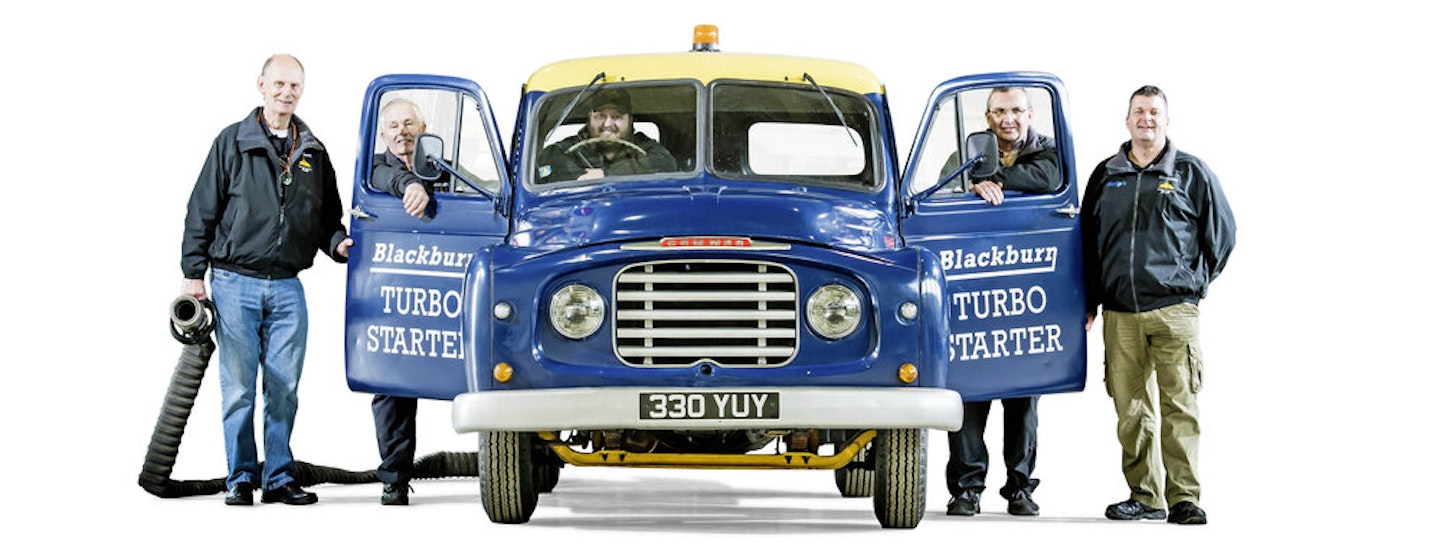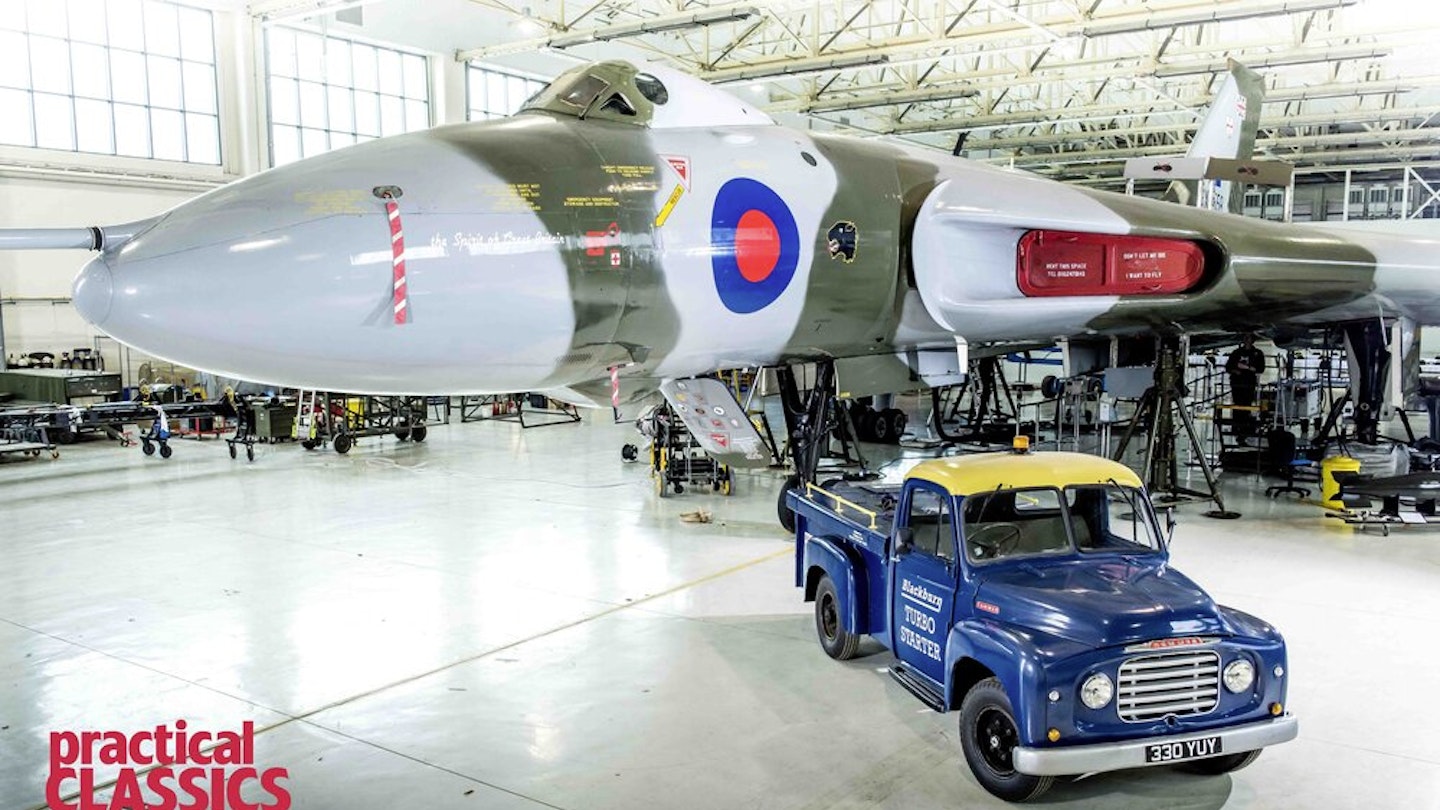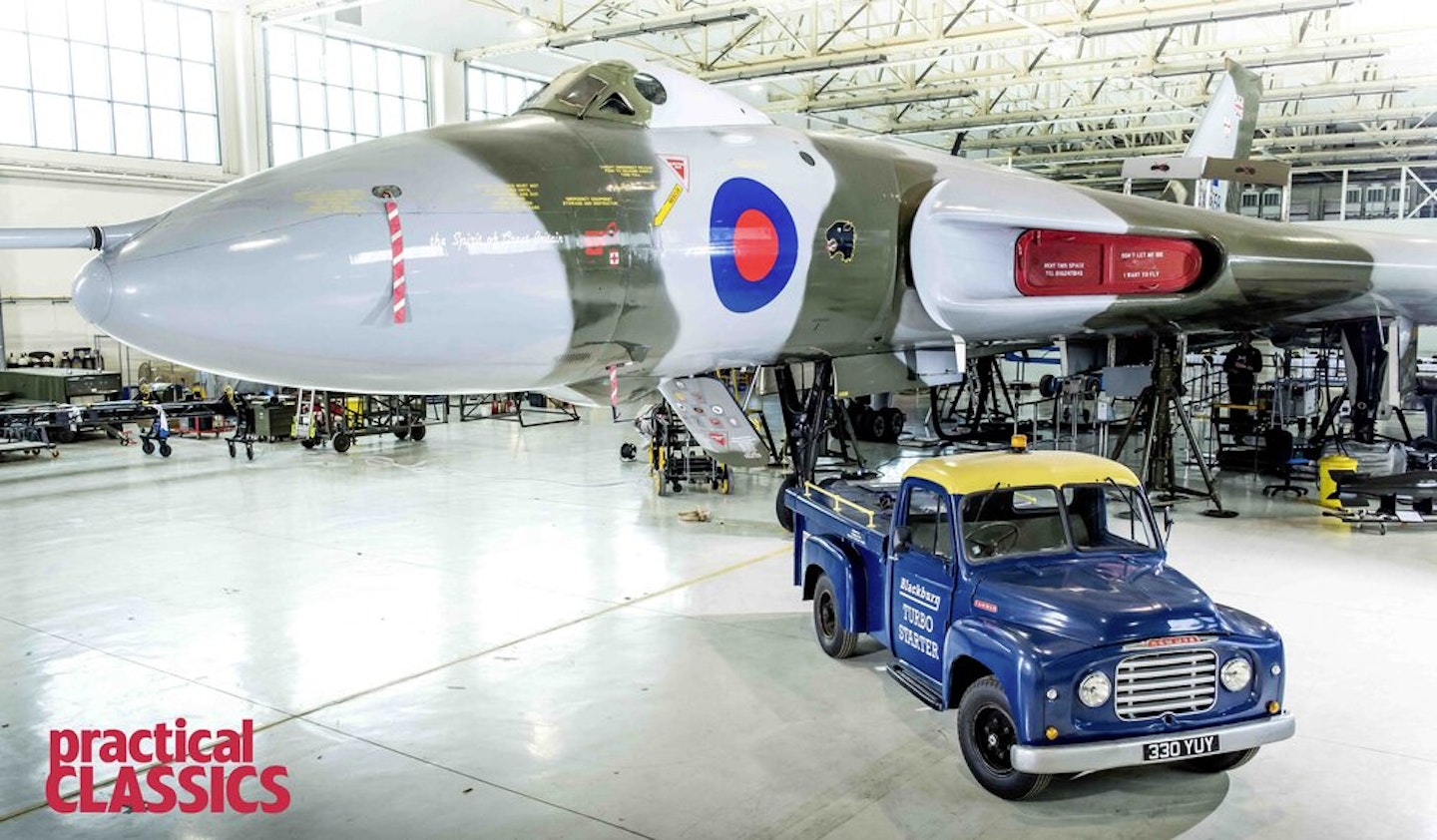
At first sight, walking into the hangar dominated by the Vulcan’s brooding presence, that other resto looks completely unremarkable. A flatbed van… a Commer Pick-up of 1960 vintage parked discreetly under the Vulcan’s port wing. Obviously a service vehicle, it has the look of hard work about it with a little light on the cab roof. It also has the name ‘Blackburn’ and words ‘Turbo Starter’ written on the side. Very interesting. Before reaching the van I’m intercepted by the team who have worked to restore it.

In service following its remarkable restoration with the Buccaneer at Bruntingthorpe.
This formidable group of five men first met at Bruntingthorpe airfield when they began working together on the Vulcan. ‘We were part of the aircraft’s volunteer restoration team,’ says retired farmer Ron Cobb. ‘All of us were Bruntingthorpe locals who got stuck into assisting the professionals during XH558’s rebuild. We were there for 10 years or thereabouts, so when it finally took to the sky and headed for its new home here at Doncaster, it left a big hole in our lives. We were suddenly redundant.’
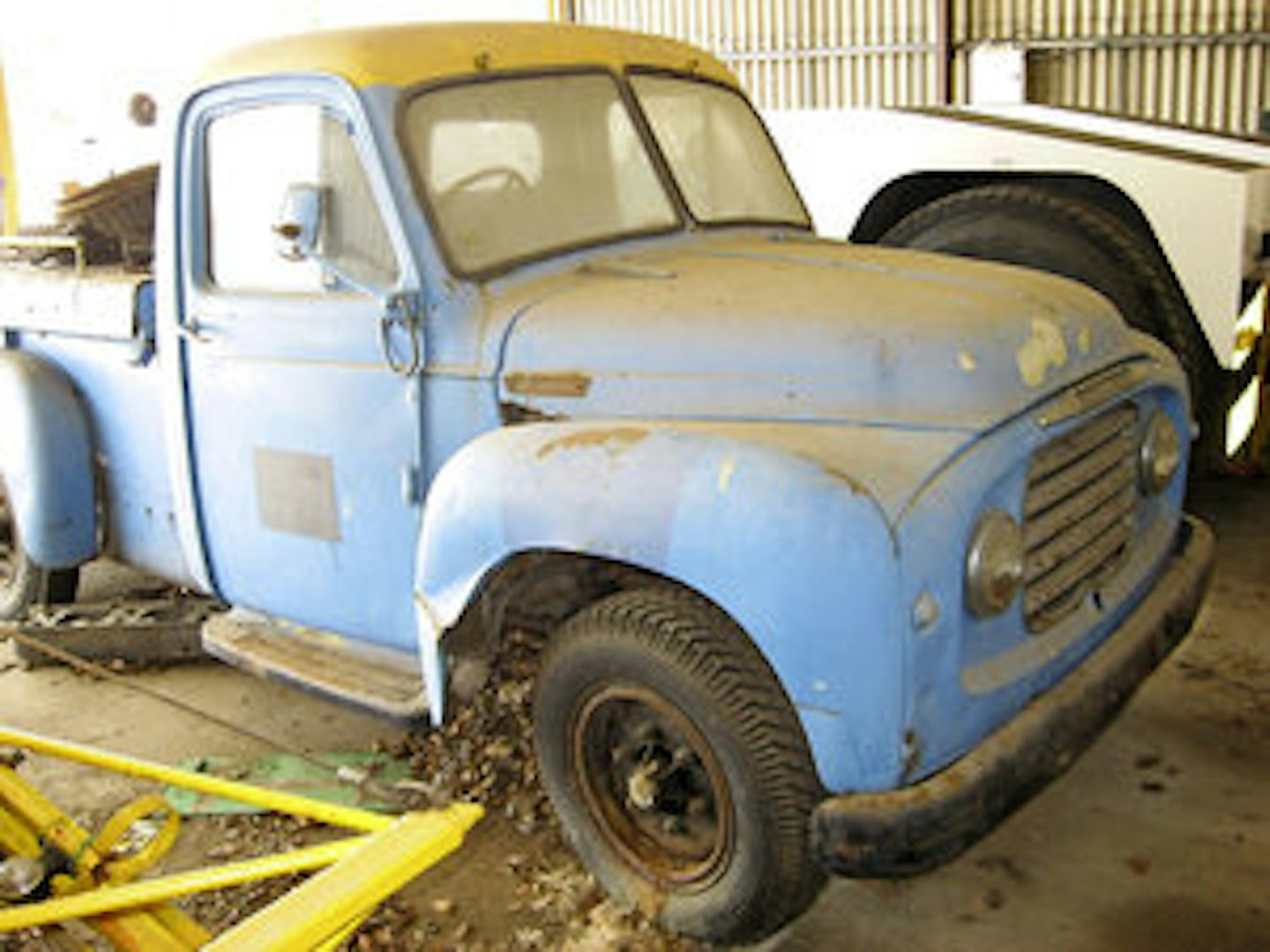
It had spent its life starting Nimrods at RAF Woodford
Another project was required, so Ron and fellow Vulcan volunteer George Barton began searching, though it was Vulcan engineering manager Andrew Edmonson who struck restoration gold. ‘It was in a lean-to at the former RAF Woodford,’ says Andrew. ‘We were offered it because they were having a clear-out and of course we jumped at the chance… Blackburn Turbo Starters were regularly used to start Vulcans, so it was the perfect project.’
The principle behind an air turbo starter is simple. It’s basically a giant hairdryer powered by a gas turbine. It supplies air at huge velocity to a jet engine to rotate the compressors ahead of the engine ignition sequence.
‘Using an air starter avoids using a cartridge system or any onboard supply system,’ explains Andrew. ‘Blackburn was the major supplier of these kits back in the early-Sixties and the example we discovered had spent most of its life spinning Nimrod engines into life. Ron and George took it on and whisked it away to the Vulcan to the Sky HQ in Hinkley.’
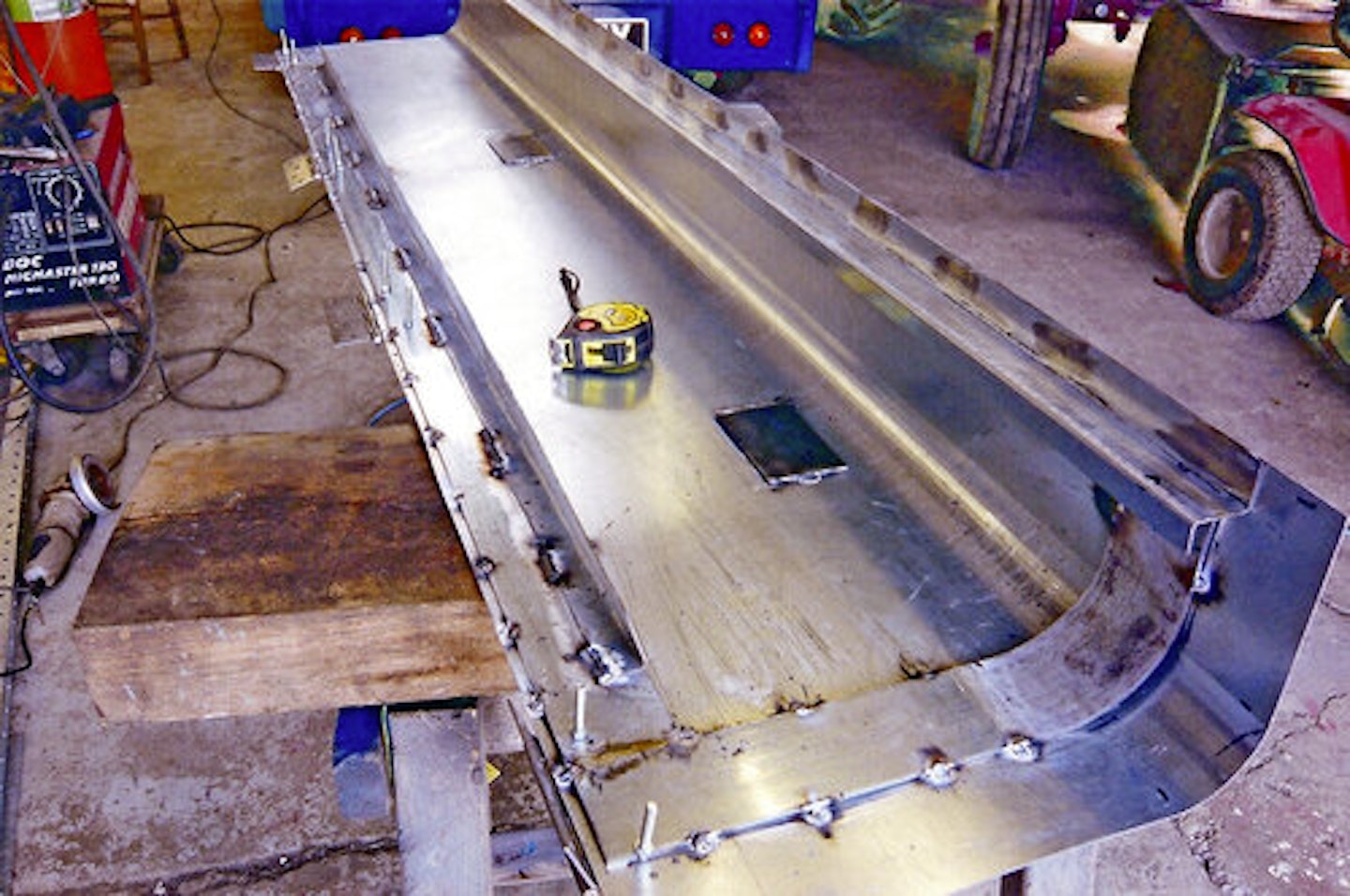
Ron’s new hose side compartment lid. Brilliant, invisible and testimony to his skills.
George got cracking, looking into the history of the vehicle and eventually turning up a Turbo Starter handbook among other things. Built by Rolls-Royce to a French design, the Palouste gas turbine doesn’t come with a Haynes manual.
Ron, meanwhile, started on the bodywork with Vulcan ground support team member Mark Malin and project engineer Derek Briginshaw. ‘We started by taking it apart and then getting stuck into the cab floor areas and bulkhead,’ recalls Ron. ‘I removed some panels and took them back to my farm to work on them properly. There was welding to be done and an awful lot of dent rectification. The bonnet in particular needed a significant amount of work.’
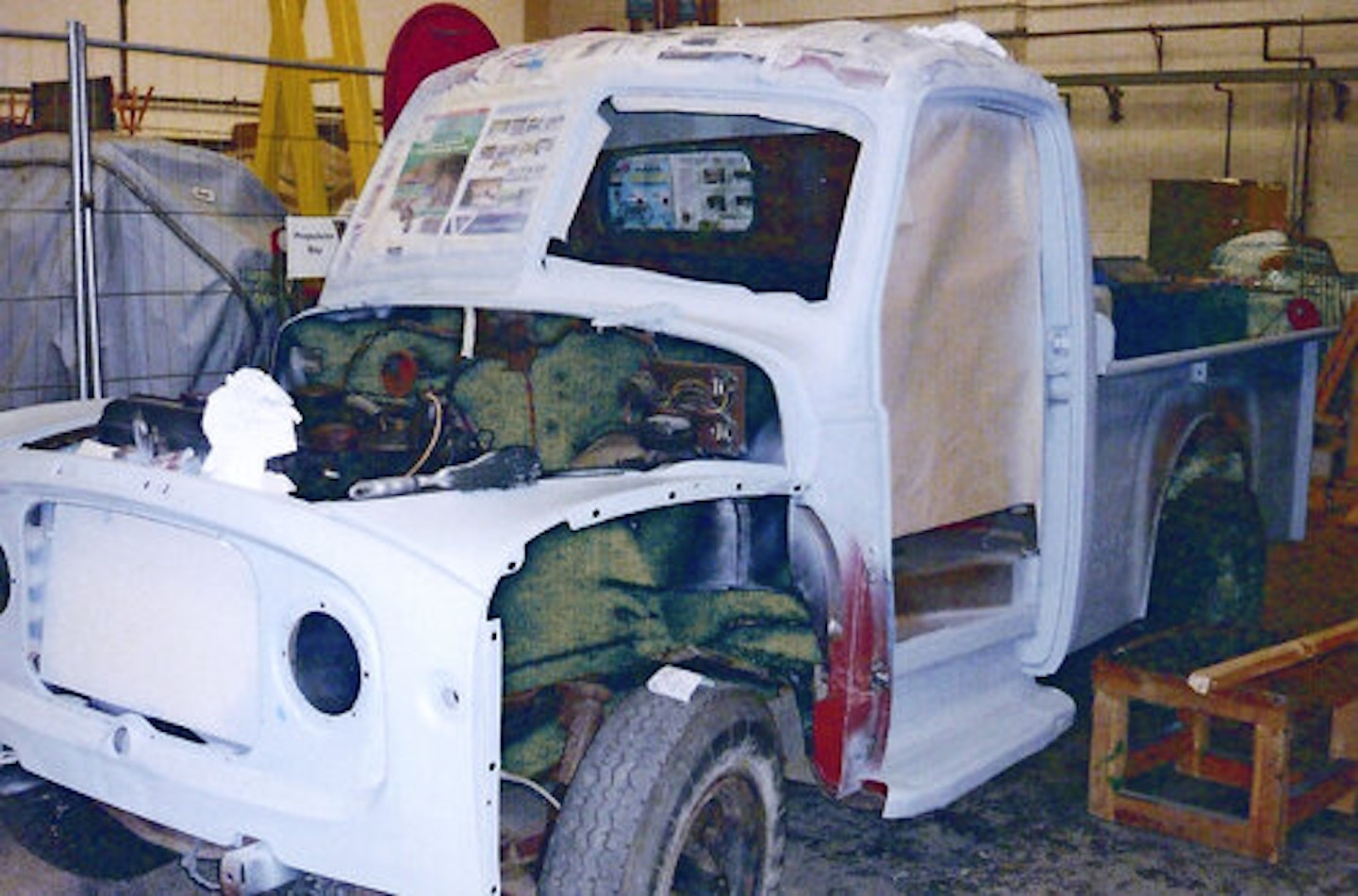
Pictured in Hinkley, where most of the bodywork was done including the badly dented bonnet.
Ron and the bodywork team replaced rot and refinished panels at great speed. After a couple of months the panels were ready for paint, but a few modifications were required. ‘This van had lived all its life on the airfield at Woodford,’ explains Ron. ‘It wasn’t even registered until 2013 when we finished it! We managed to get an age-related plate.’
Some of it needed ‘finishing’ for road use. For instance, there was no real means of storing the air pipe that takes the high-pressure air from the turbo to the aircraft. ‘I cut into the cavity next to the turbo compartment and hinged a lid over it. Job done,’ says Ron. Like most problem-solving engineers, Ron makes this sound easy. The result is elegant, invisible and brilliant. A testament to his skills.
Fordson Agricultural Blue was the perfect hue for the Turbo Starter’s flanks. It was applied in a week and once dry, bespoke transfers and decals were added. Colour and design were decided upon after studying period images plus a petrol bowser at Brooklands Museum, which also came from RAF Woodford.
The rebuilt and repainted cab and back body were reunited with the chassis, which was in excellent condition. A Palouste was sourced and installed. It needed cleaning up and rewiring. Step forward volunteer and electrical engineer Dave Seaton.

‘Luckily George found a wiring diagram at RAF Woodford,’ says Dave. ‘I rewired the entire truck, including the separate system for the turbo starter. It has its own 28v generator driven from the turbo and it’s all wired up to aviation spec with wiring ‘borrowed’ from the Vulcan restoration.’
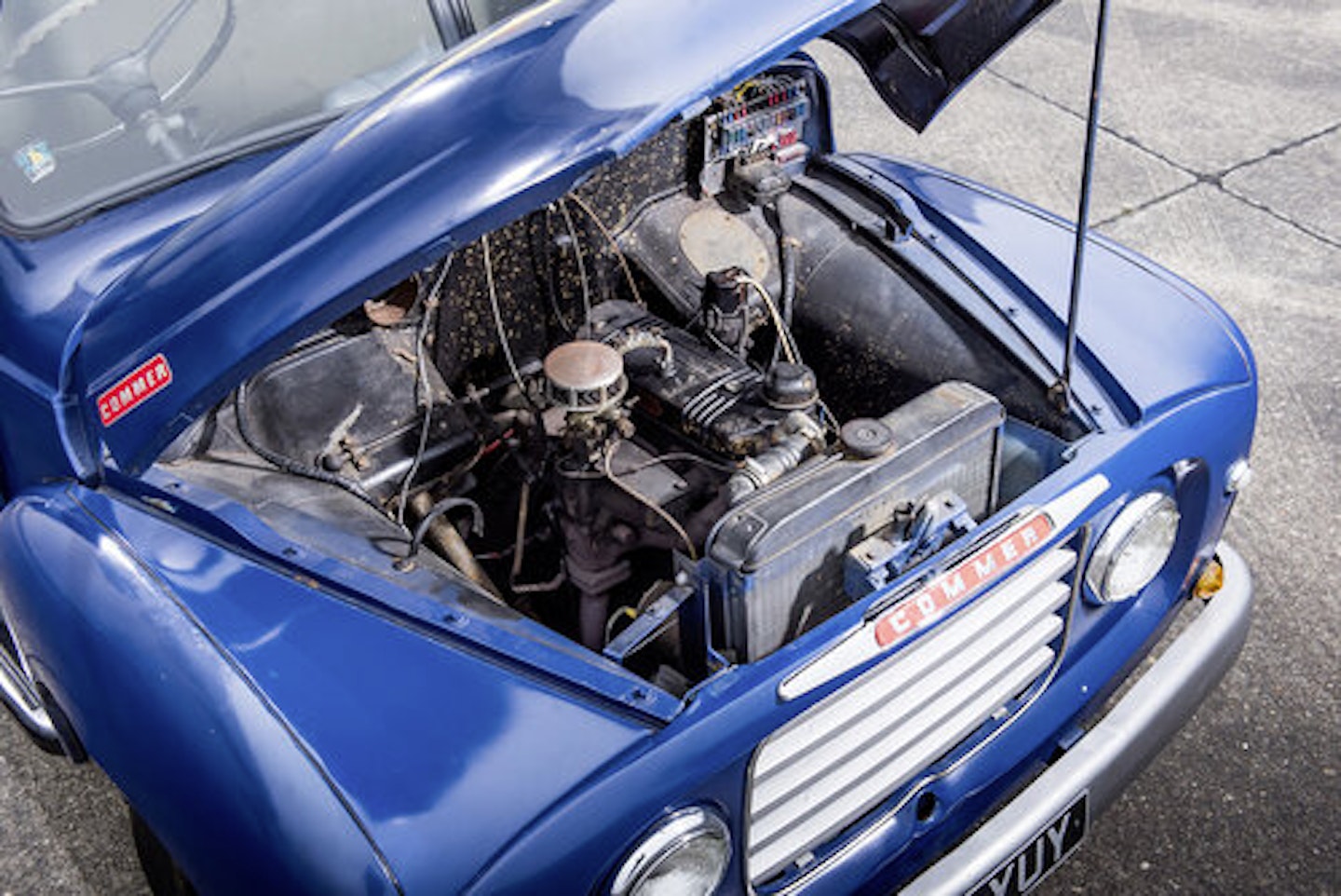
The team wanted a working vehicle, so Dave was tasked with starting the unit. ‘We serviced it, wired it up and stood it in a field at Bruntingthorpe. Then we stood back – quite a long way – and fired it up to see what would happen. At first it kept cutting out. A filter needed replacing. That done, we took the engine from idle to boost.’ The team dared to venture nearer. ‘Full power and all was well. We scared the local wildlife though – quiet it isn’t.’
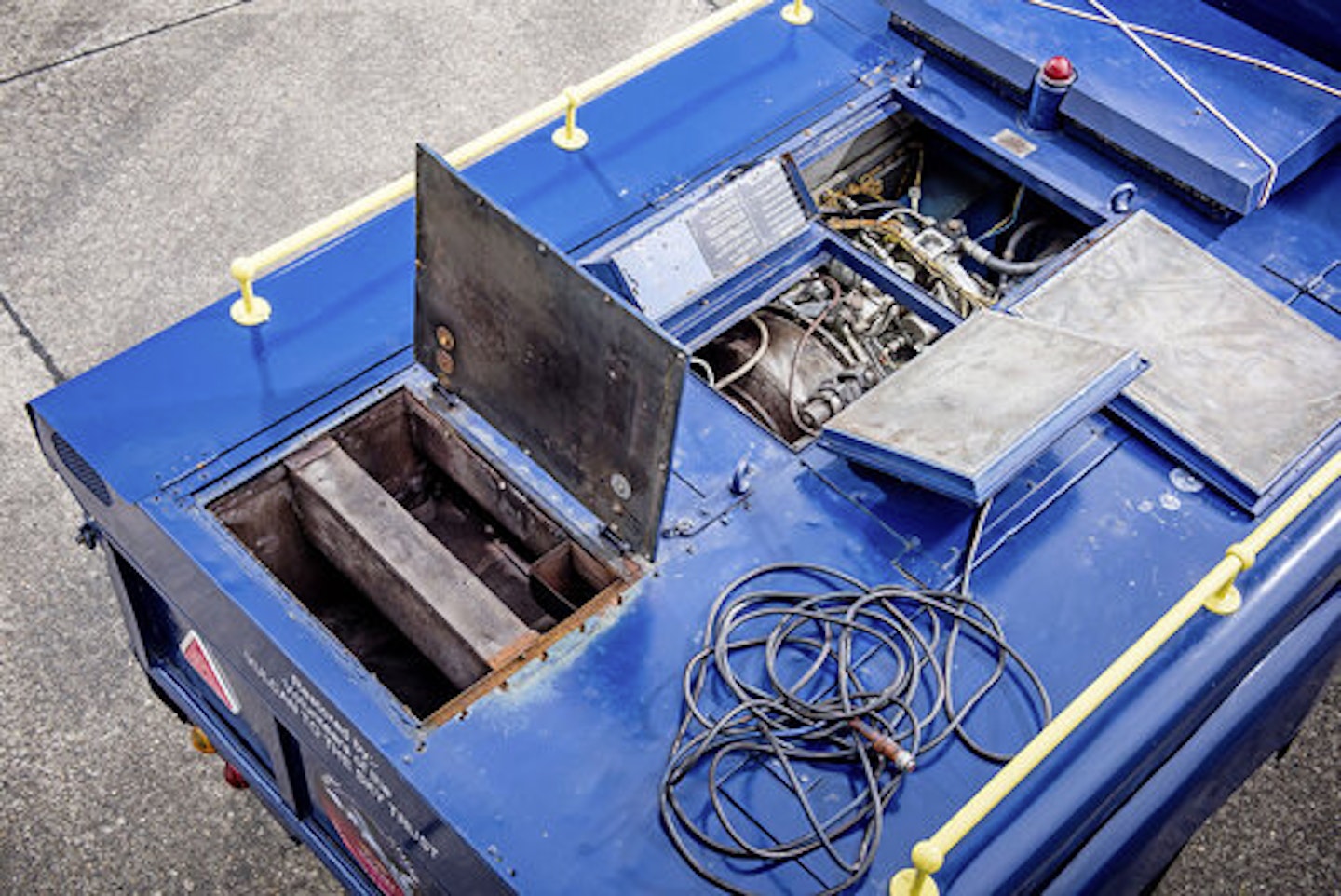
The van was completed with new screen rubbers, a new pane of glass, and seats retrimmed using a retired Vulcan parachute bag! The wing seals were borrowed Vulcan door seals… an almost perfect fit. The cab floor matting, again, was Vulcan spec, being the matting used on the Vulcan’s cockpit floor. Mark Malin is unapologetic: ‘There’s quite a lot of Vulcan in this truck as it happens. But I don’t think anyone minds.’
The truck’s wiring loom was almost more challenging than the Turbo Starter. ‘There was no diagram for the truck, so I wired it up as a blank canvas and made it up as I went along,’ says Dave. ‘Compared to a telephone exchange [his usual subject], it’s quite simple. I converted it to negative earth and fitted modern relays and flasher units.’
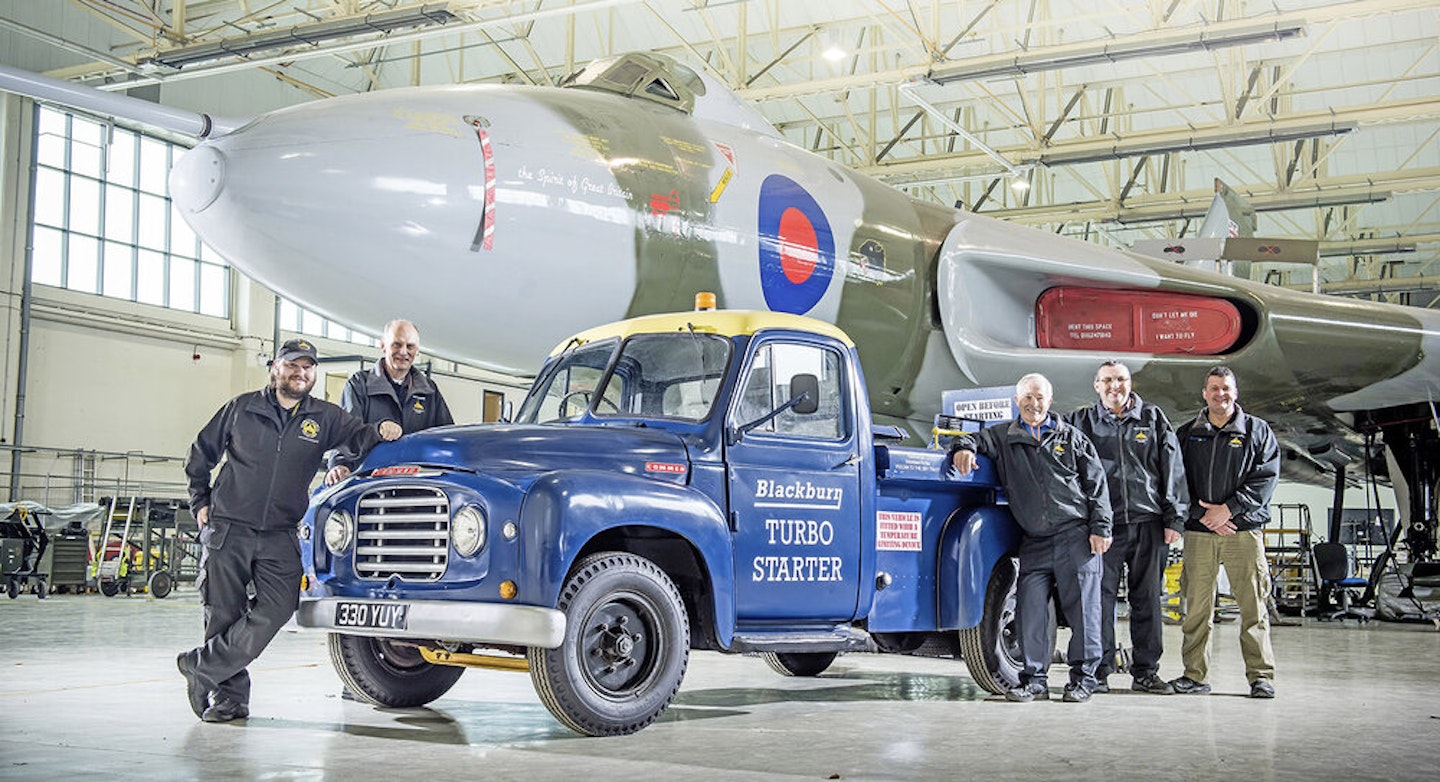
Structural engineer Simon Chipman and Mark Malin worked on the truck’s engine, steering and brakes. ‘The old Humber Hawk lump was virtually new, having only 10,000 miles on the clock,’ says Mark. ‘It needed a new water pump though, which was a tough search. I ended up taking it to bits and rebuilding it with new seals. Then we searched high and low for tyres… we eventually sourced the correct 750x16 items from Portugal.’ Mark and Simon got stuck into the brakes and steering that again, without a Haynes manual to guide them, was another intuitive expedition. But intuition paid off because, after a test run at Bruntingthorpe it was off to the MoT station where the truck went straight through, first time.
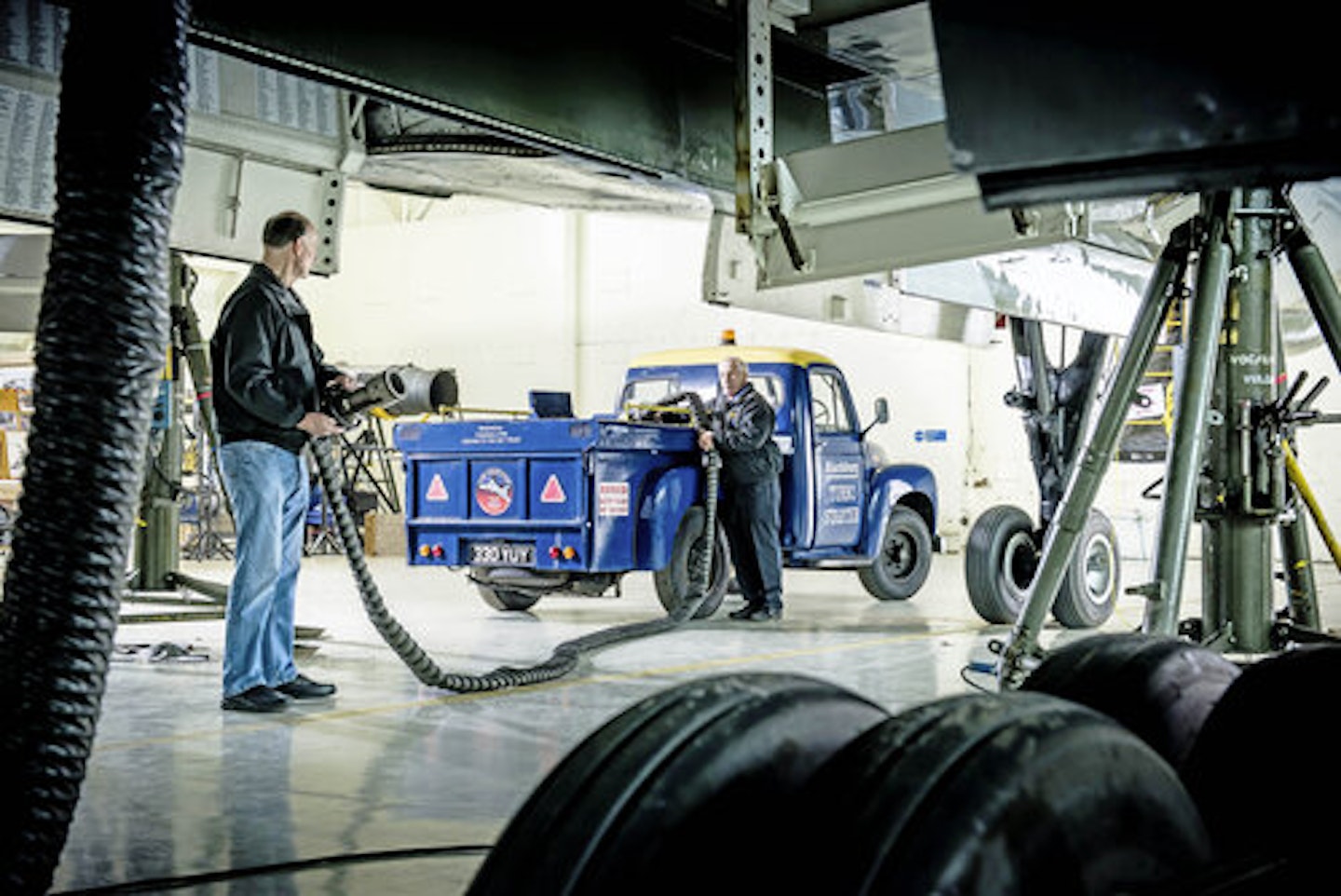
Since then the team has used the truck as a promotional vehicle, accompanying them on fundraising events and displays. The big question is, though, has it been used to start a jet yet? Ron has the answer. ‘Yes. Once. We were at the Bruntingthorpe Cold War Jets day last year and the team who run the Buccaneer came running over and asked: ‘Can you do us a favour?’ Their stationary air starter had failed. We jumped at the chance and plugged the Blackburn in. It worked! ‘Starting the Vulcan remains another question’, admits Ron. ‘To fire up a Vulcan, the starter works on number four engine and then, once that’s going, the pilot cross-feeds to engines three, two and one.
The Vulcan also needs a generator to bring its systems to life – a 28v DC, 200v AC Houchin Cummins diesel unit. Starting a Vulcan is quite a process.’ The team mock up the operation they would one day like to perform as the Vulcan rests. It was horrible to think that this would be the last year any of us would see a V-bomber up there, in the sky, where it belonged – but as Dr Seuss said: ‘Don’t cry because it’s over, smile because it happened.’
Farewell, Vulcan
As this feature originally went to press, the world’s last airworthy Avro Vulcan had just flown its final sortie. It was 2015, XH558’s last flying year, her airframe having exceeded the 250 flying hours promised before restoration began – more flying hours than any other Vulcan.
Restored over four years, Roy Chadwick’s V-bomber masterpiece roared into the air again on Thursday October 18, 2007 – 14 years after her last flight in service. It was a huge achievement costing more than £7million, but it was worth every penny. A generation had been inspired. A dedicated band of volunteers, a new Delta Force, assisted the restoration engineers who made the Vulcan to the Sky project viable. They helped to raise funds, provided expertise, and were a stunningly effective public relations army – and a few of them completed another remarkable restoration all of their own…
